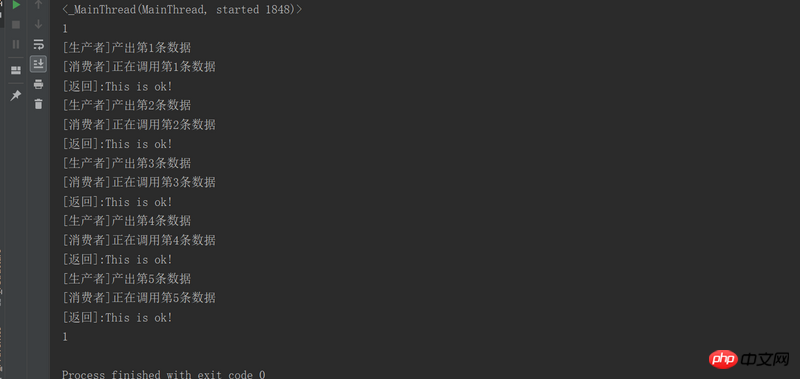
This article brings you a detailed explanation of coroutines in Python (with examples). It has certain reference value. Friends in need can refer to it. I hope it will be helpful to you.
Coroutines, also known as micro-threads and fibers. The English name Coroutine
Coroutine looks like a subprogram, but during execution, it can be interrupted inside the subprogram, and then switch to executing other subprograms, and then return to continue execution at the appropriate time.
yield implements coroutines
Python's support for coroutines is still very limited. Yield used in generators can implement coroutines to a certain extent. Although the support is not complete, it can already exert considerable power.
import threading
import time
def producer(c):
c.__next__()
n=0
while n c.send(n) --> n更新
n = yield r
if not n:
break
print('[消费者]正在调用第%s条数据' %(n))
time.sleep(1)
r = 'This is ok!'
if __name__=='__main__':
print(threading.current_thread())
print(threading.active_count()) #查看当前进行的线程
c = consumer()
producer(c) #函数中有yield, 返回值为生成器;
print(threading.active_count()) #1
gevent library implements coroutines
Python provides basic support for coroutines through yield , but not completely. The third-party gevent provides relatively complete coroutine support for Python.
gevent is a third-party library that implements coroutines through greenlets. The basic idea is:Since switching is automatically completed during IO operations, gevent needs to modify some of the standard libraries that come with Python. This process is completed through monkey patch at startup.
Assuming that the tasks executed by multiple coroutines have no IO operations or waiting, then the coroutines run sequentially instead of alternately;
Assuming that the tasks executed by multiple coroutines have IO operations or waiting, then Coroutines run alternately;
#没有等待
import gevent
from gevent import monkey
monkey.patch_all()
def job(n):
for i in range(n):
print(gevent.getcurrent(),i)
def mian():
g1 = gevent.spawn(job,1)
g2 = gevent.spawn(job,2)
g3 = gevent.spawn(job,3)
gevent.joinall([g1,g2,g3])
print('协程执行任务结束...')
if __name__=="__main__":
mian()
"""
#有等待
import time
from gevent import monkey
monkey.patch_all()
import gevent
def job(n):
for i in range(n):
print(gevent.getcurrent(), i)
time.sleep(1)
def main1():
# 创建三个协程, 并让该协程执行job任务
g1 = gevent.spawn(job, 2)
g2 = gevent.spawn(job, 3)
g3 = gevent.spawn(job, 2)
# 等待所有的协程执行结束, 再执行主程序;
gevent.joinall([g1, g2, g3])
print("任务执行结束.....")
main1()
Coroutines Do a comparative experiment on the time spent by coroutines and threads with threads
, which is not informative.
import time
import gevent #导入协程
from gevent import monkey
from urllib.request import urlopen #连接网络
from mytimeit import timeit #导入计算时间的装饰器
from concurrent.futures import ThreadPoolExecutor #导入线程池
def get_len_url(url):
with urlopen(url) as u_conn:
data = u_conn.read()
# print('%s该网页共%s字节' %(url,len(data)))
urls = ['http://httpbin.org', 'http://example.com/']*100
@timeit
def coroutineall():
gevents = [gevent.spawn(get_len_url,url) for url in urls]
gevent.joinall(gevents)
@timeit
def threadall():
with ThreadPoolExecutor(max_workers=100) as thpool:
thpool.map(get_len_url,urls)
if __name__=="__main__":
coroutineall()
threadall()
The above is the detailed content of Detailed explanation of coroutines in python (with examples). For more information, please follow other related articles on the PHP Chinese website!
 setInterval
setInterval
 What is the shortcut key for brush size?
What is the shortcut key for brush size?
 Detailed explanation of linux dd command
Detailed explanation of linux dd command
 How to solve disk parameter errors
How to solve disk parameter errors
 What are the SEO diagnostic methods?
What are the SEO diagnostic methods?
 What are the css3 gradient properties?
What are the css3 gradient properties?
 The most promising coin in 2024
The most promising coin in 2024
 What does pycharm mean when running in parallel?
What does pycharm mean when running in parallel?
 The difference between PD fast charging and general fast charging
The difference between PD fast charging and general fast charging